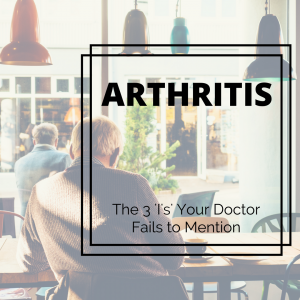
Arthritis can be debilitating. In fact, arthritis and rheumatoid conditions are the leading cause of disability among US adults for the past 15 years. So when your doctor is assessing your spine and joints and makes mention of ‘normal degenerative changes,’ that should be a clue to find another doctor.
There’s nothing normal about arthritis and join degeneration. For your body to be in an active destruction of a joint, especially when not trauma induced, there’s a whole mess of ‘not normal’ going on.
The major problem with traditional healthcare is that they see the arthritic changes and resultant pain as the problem. I would argue they are the effect of many other processes in your body giving you a repeated fighting chance of survival and a breaking point happens. But for 98% of us, it’s not random chance and we’re not part of the unlucky club.
There are 3 ‘I’s’ that your primary or rheumatologist fail to address when assessing and treating arthritis. Actually, they talk a lot about one of them, but their solutions actually cause more imbalance and worsen the condition long term.
Intestinal Permeability:
Your rheumatologist may compartmentalize your gut as just a function of digestion. And if that’s the case, find a new doctor. The point being is that your gut is one of your first line of defenses in your immune expression. This is mediated through an expression of one of your immunoglobulins, SIgA (Secretor IgA).
Secretory IgA is produced in the lining of the gut via the Peyer’s patches. It’s an important line of defense in fluids like saliva and lives in the mucous membranes of the nose and lungs. When a threat is detected, secretion of SIgA increases in areas where we produce mucous. It basically works like lubrication so the nasty things can’t stick and attach to your body. The attack is only against things that are harmful and has a broad spectrum of immune responses. It’s non-specific.
 While you may build antibodies against a flu strain via IgE, IgA, or IgG, those will only fight when exposed to those viruses. SIgA has you covered in all instances. Best of all, that protection happens without you feeling it. It actually does all this work while not triggering the rest of the system.
While you may build antibodies against a flu strain via IgE, IgA, or IgG, those will only fight when exposed to those viruses. SIgA has you covered in all instances. Best of all, that protection happens without you feeling it. It actually does all this work while not triggering the rest of the system.
If you’re trying to escape from a rabid squirrel and have to swim through a nasty swamp filled with parasites and fecal material, you’re covered. SIgA jumps into action and protects you while you swim away from the fur ball.
SIgA also has the ability to attach to large food particles that haven’t been digested well. This is to minimize wear and tare on the gut lining. It’s like the pads you put under your couch legs to slide across the floor so you don’t scratch it up.
Best of all, SIgA prevents inflammation. Inflammation is one of those ‘I’s’ that often gets talked about by a rheumatologist but their treatment of it creates a worse problem. Inflammation is just a host of signals from your immune system, alerting the need for attacking and protection. If overtime your gut elicited this response, you would be constantly doubled over in pain. You owe a HUGE thank you to SIgA for not having this happen. It’s like the Navy Seals. You’re grateful for what they do but glad you don’t know all the details of their mission.
By keeping the internal panic low, SIgA is helping you maintain a strong gut barrier.
When SIgA Gets Weak
The actions of SIgA are regulated by your adrenals, more specifically the hormones Cortisol and DHEA. Why would your adrenals kick into gear? Stress.
But stress isn’t just an emotional troll. Stress is anything that moves your body into a deficient or toxic state. It can be relationships, food, movement patterns, social isolation, infection, medications, as well as emotional aspects. No matter the type of stress, your body will elicit a similar reaction just to make sure you survive it.
Regardless if you’re running from a rabid squirrel or just binged watch 3 seasons of Breaking Bad, the adrenals will kick into gear to release Cortisol and DHEA to trigger the action of SIgA. The more someone lives in this chronic stress mode, this creates an imbalance between those two hormones that create that first line of defense. The Navy Seals have been under fire too long without backup and are running out of ammunition, water, and energy.
The mucosal barrier breaks down and those pathogens or large food particles that would essentially slip on by, now have the opportunity to damage the gut lining. That damaged lining doesn’t just allow leakage into the surrounding environment, the mechanisms for nutrient absorption is also compromised. And since the SIgA immune response is low, this alerts the other immunoglobulins (pro-inflammatory) to attack and this starts the cascade of inflammation (cytokines).
What I am describing is ‘leaky gut.’ But for some reason that term turns a lot of people off. So instead of talking to your doctor about leaky gut, talk to him about intestinal permeability and Secretory IgA.
Inflammation
The solution with most treatments of arthritis is that they are geared at cutting out inflammation. The problem is that they are geared at cutting out a middle step of inflammation opposed to the prime source. Inflammation is looked at as the enemy. In acute conditions, inflammation is tissue dysfunction. But when it becomes chronic, it becomes tissue destruction.
Steroids
Most arthritic conditions are treated with steroids (Corticosteroids). What is a corticosteroid? Cortisol. And what does cortisol help you do? Trigger the action of SIgA, to support your first line, anti-inflammatory line of defense. In addition to that SIgA response, cortisol will convert to cortisone. Many people get these powerful injections to alleviate pain.
The intent behind giving corticosteroids to arthritic pain sufferers is ok but the outcome is unintelligent. Cortisol is only 1 piece in that strong SIgA response. They are forgetting the balance of DHEA. So why not do both? Because the more we naturally release cortisol, this puts the body into a state of tissue break down.
The oral corticosteroids or the injections are essentially putting you in repeated bouts of fight or flight. If we are escaping a rapid squirrel and twist an ankle, it doesn’t swell up or create that much pain…until we get to safety and relax a bit. The repeated medical onslaught of fight or flight is no different. It’s like sprinting on 2 broken ankles. You may not feel anything but you’re not going to escape either.
In order to repair that gut lining and re-establish a good SIgA response, you have to remove stress, not mask it or add to it.
NSAIDS
These are the non-steroid versions of pain relievers. And again, the intent is good but the outcome is unintelligent. The purpose of NSAIDS is to block one of the inflammatory signals called prostaglandins. Remember, inflammation isn’t always the enemy.
Prostaglandins are part of the cascade of signals that are produced from essential fatty acids, especially from Omega 6 ones that are derived from grains and vegetable oils. In that pathway from Omega 6 to prostaglandins there are enzymes called cyclooxygenases (COX). There are 2 types (1 and 2) of COX enzymes. Both will produce prostaglandins that promote inflammation, pain, and fever but COX-1 will produce prostaglandins that activate platelets and protect the stomach and intestinal lining.
Did you catch that? The attack on prostaglandins creates an attack on the intestinal lining. If your gut lining is compromised, what happens to your inflammatory load? It increases because you’ve wiped out your SIgA protective mechanisms.
Both steroids and non-steroid medications will help you feel great in the immediate as the squirrel eats your eye balls but the repeated use of those medications does nothing but continuously contribute and exacerbate the problem in the first place.
And I hope you didn’t miss the point of Omega 6’s (grains and vegetable oils). The more you consume those type foods, the more those fats convert into prostaglandins. This shouldn’t be a problem if the Omega 3s are in a great ratio. The more I run omegas on labs, the more I see a major dominance of Omega 6 and a major deficiency in Omega 3.
But grains and the abundance of Omega 6 isn’t the only issue. Another major issue in joint pain and arthritis is insulin resistance.
Insulin
One of the major issues with a high grain diet is that it translates into a high sugar diet. And when there is high sugar, there is high insulin. And when this is repeated, the whiny, nagging voice of insulin starts getting ignored and the excess sugar doesn’t have a place to go. Sugar then ends up walking the streets, turning tricks.
Sugar prostitutes itself out to fats, creating an abundant of illegitimate kids called triglycerides. And it also hooks up with proteins to create an offspring called A.G.E.s (Advanced Glycosylated End-products). These A.G.E.s are nothing more than when you burn toast. A sugar and protein together isn’t an issue. The issue is when you add heat to it.
This process is called glycation. When that sugar and protein combine and heat is added, the protein doesn’t work properly. In the case of arthritis and degeneration, the damage occurs when that specific protein is collagen. With collagen, the problem occurs because that protein no longer retains water. The discs of the spine, your skin, your arteries, and joints are going to dehydrate, lose elasticity, and therefore degenerate. Stretching probably isn’t going to help that much.
Heat is the common denominator. If the body is already in a hyper inflamed state, you can assume there is a heat problem. The other source for joints specifically comes when joints aren’t rubbing properly, mis aligned, and there are muscle compensations pulling and yanking from all directions.
With that said, the path to arthritis and degeneration development and resolution doesn’t have a direct route. While there are commonalities, there are many life experiences that shape the severity and intensity of your pain. If you need help navigating the terrain, you know how to find me.


0 Comments